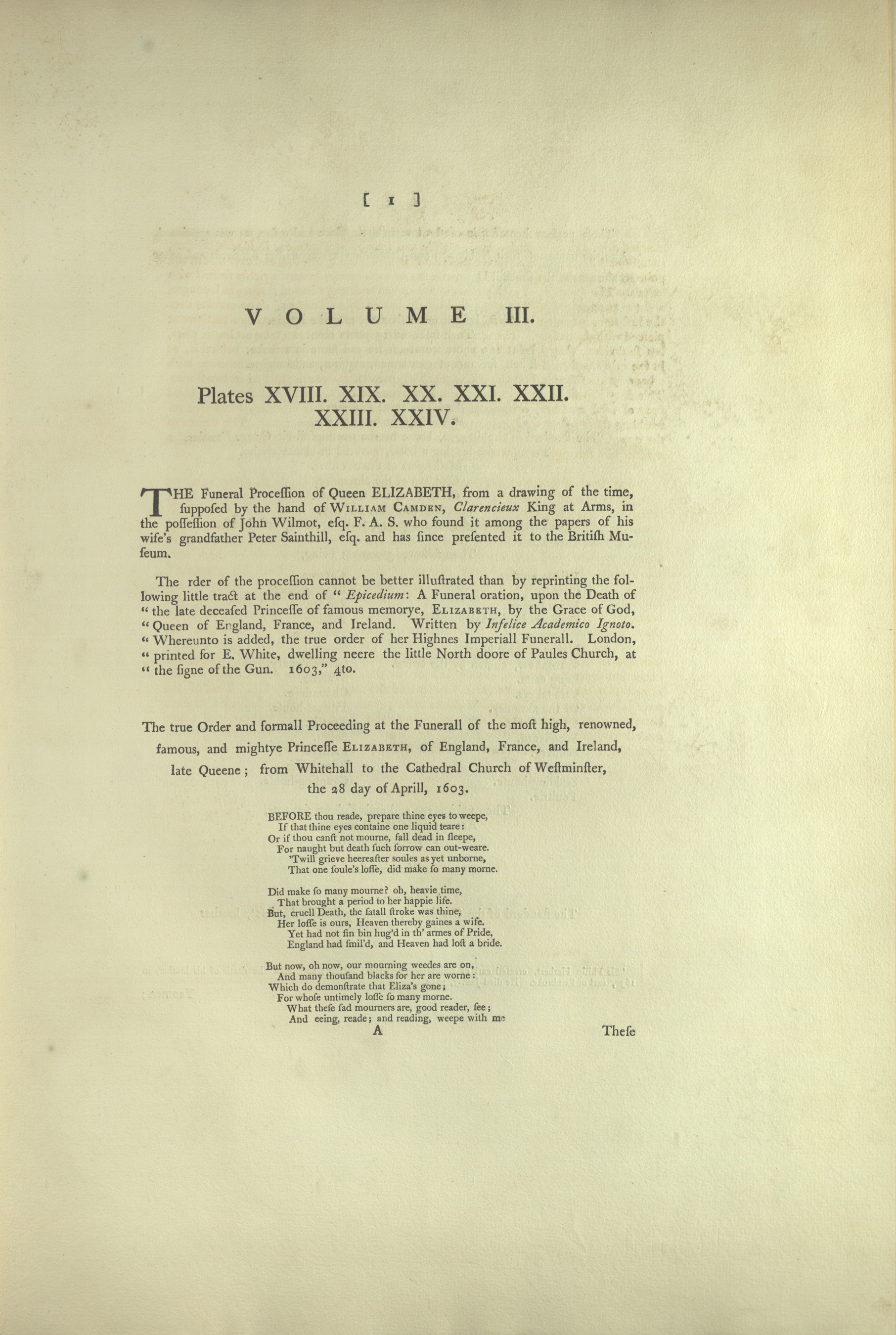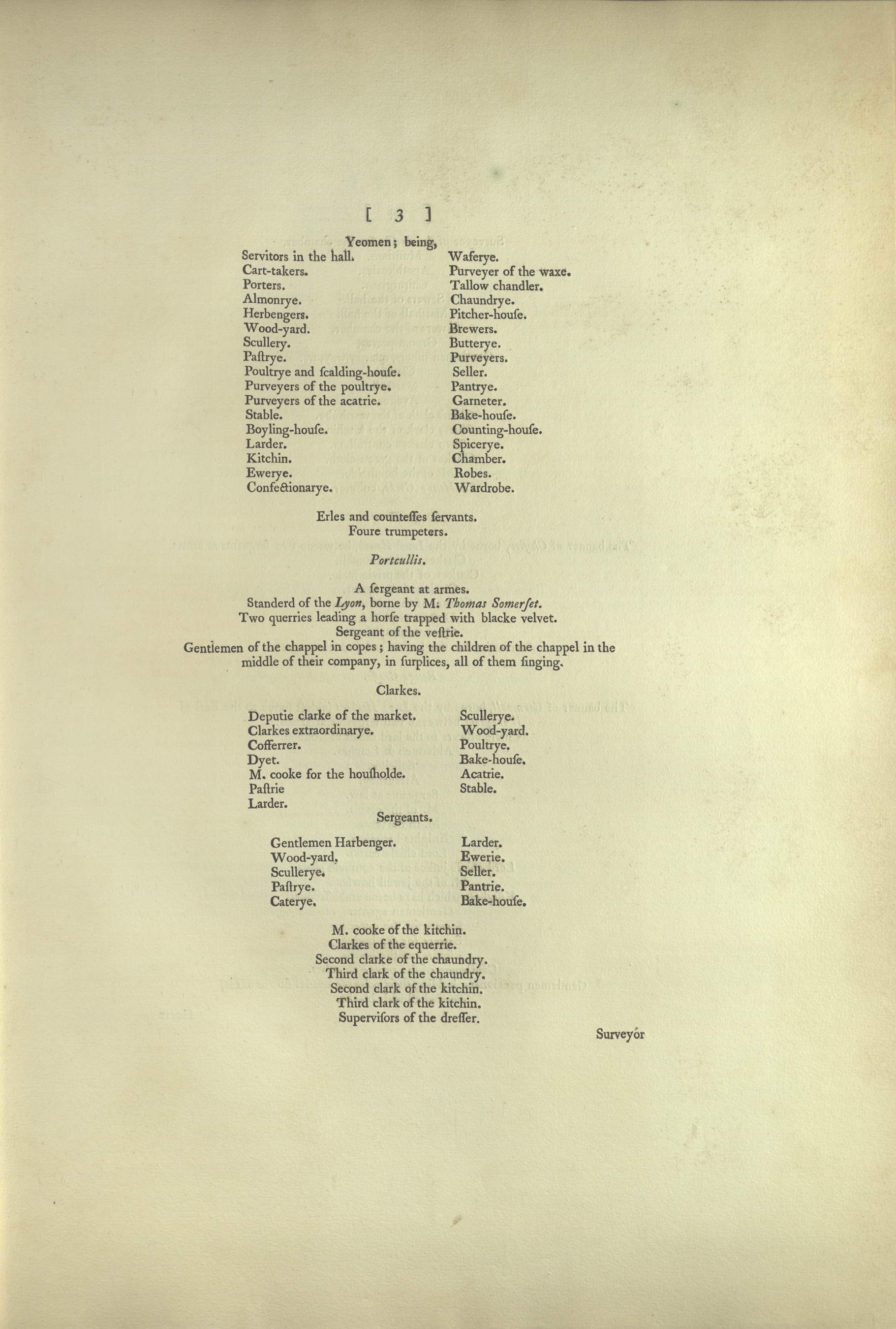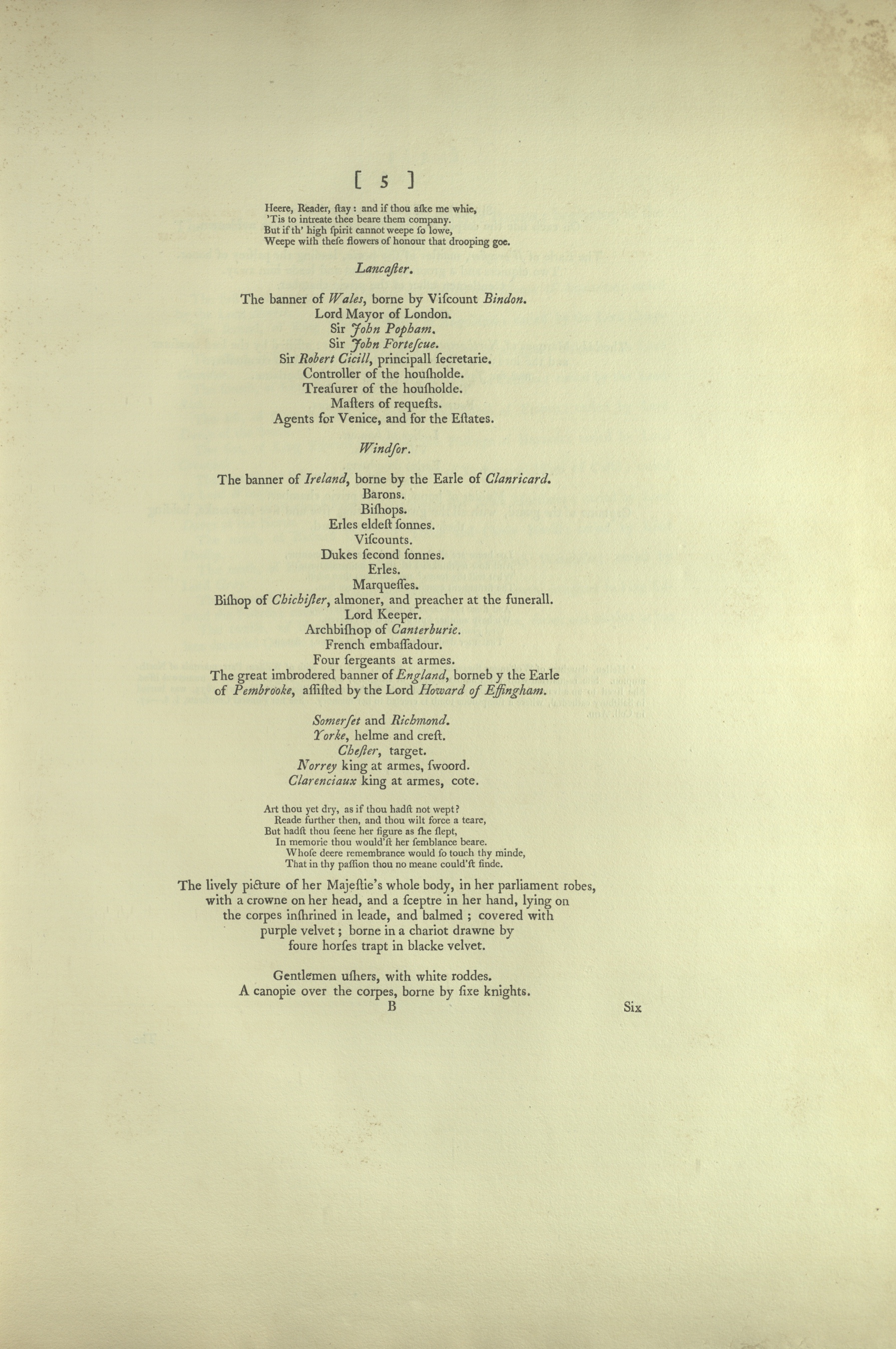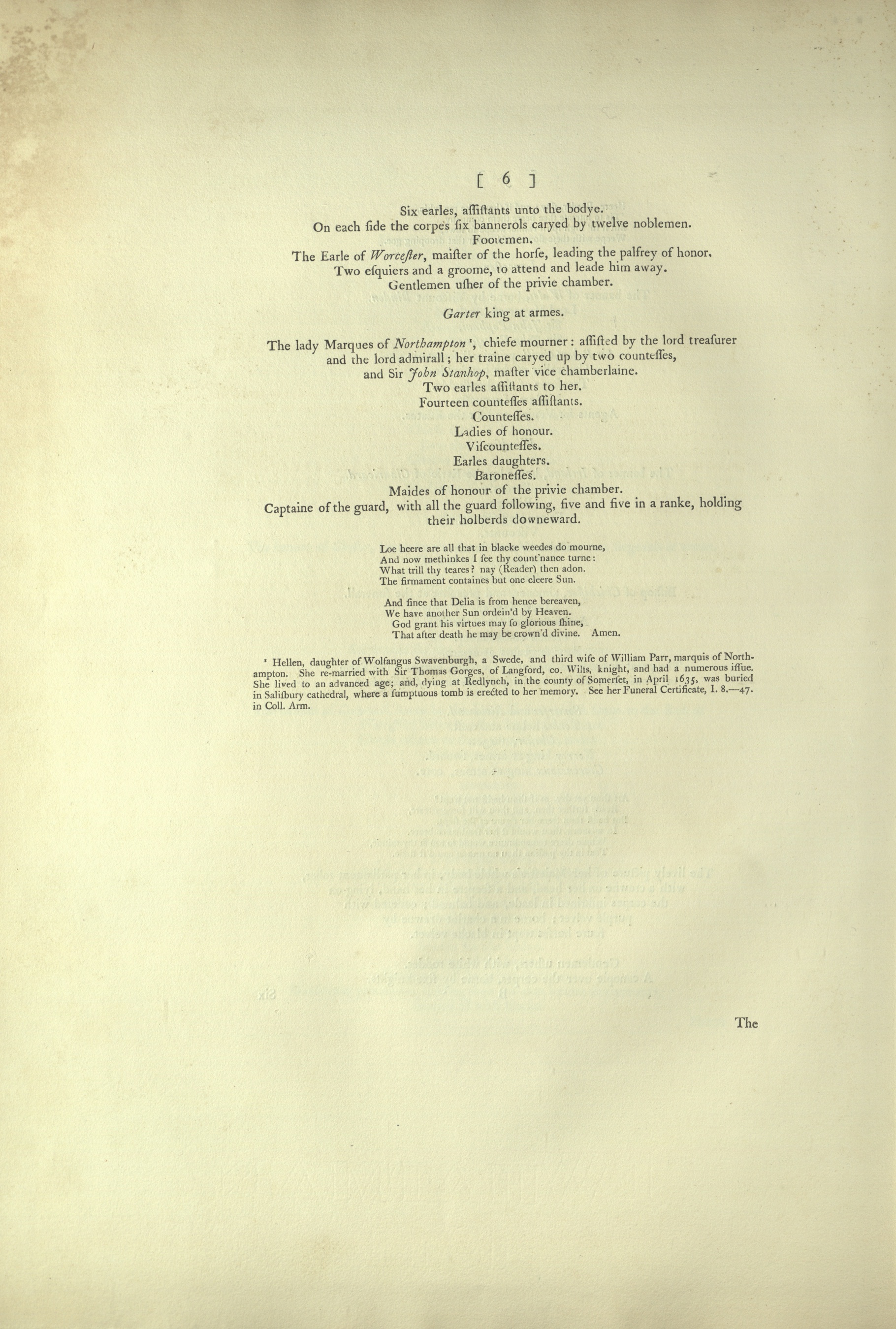
Creative Commons Attribution-Noncommercial-No Derivative Works 3.0
Plates 3.18-3.24: The Funeral Procession of Queen Elizabeth (Original Explanatory Account)
1 2020-07-21T10:12:20+00:00 Ariel Fried f6b6cec26c5a46c3beae9e3505bac9e8799f51de 31 17 Original Explanatory Account for Vetusta Monumenta, Plates 3.18-3.24. Written by Richard Niccols. plain 2025-10-24T18:17:49+00:00 Mary-Claire Sarafianos b64b0f9cad2b567cca4c9f2022b28f5bd47876a6
[ (Page) 1 ]
VOLUME III.
Plates XVIII. XIX. XX. XXI. XXII. XXIII. XXIV.
THE Funeral Procession of Queen ELIZABETH, from a drawing of the time, supposed by the hand of WILLIAM CAMDEN, Clarencieux King at Arms, in the possession of John Wilmot, esq. F.A.S. who found it among the papers of his wife’s grandfather Peter Sainthill, esq. and has since presented it to the British Museum.
Read more/less…The [o]rder of the procession cannot be better illustrated than by reprinting the following little tract at the end of “Epicedium: A Funeral oration, upon the Death of the late deceased Princesse of famous memorye, ELIZABETH, by the Grace of God, Queen of England, France, and Ireland. Written by Infelice Academico Ignoto. Whereunto is added, the true order of her Highnes Imperiall Funerall. London, printed for E. White, dwelling neere the little North doore of Paules Church, at the signe of the Gun. 1603,” 4to.
The true Order and formall Proceeding at the Funerall of the most high, renowned, famous, and mightye Princesse ELIZABETH, of England, France, and Ireland, late Queene; from Whitehall to the Cathedral Church of Westminster, the 28 day of Aprill, 1603.
BEFORE thou reade, prepare thine eyes to weepe,
If that thine eyes containe one liquid teare:
Or if thou canst not mourne, fall dead in sleepe,
For naught but death such sorrow can out-weare.
‘Twill grieve heereafter soules as yet unborne,
That one soule’s losse, did make so many morne.
Did make so many mourne? oh, heavie time,
That brought a period to her happie life.
But, cruell Death, the fatall stroke was thine,
Her losse is ours, Heaven thereby gaines a wife.
Yet had not sin bin hug’d in th’ armes of Pride,
England had smil’d, and Heaven had lost a bride.
But now, oh now, our mourning weedes are on,
And many thousand blacks for her are worne:
Which do demonstrate that Eliza’s gone;
For whose untimely losse so many morne.
What these sad mourners are, good reader, see;
And eeing, reade; and reading, weepe with me[.]

[ (Page) 2 ]
These persons heerafter named came in their place and order, as was appointed. Also the names of such Noblemen and Gentlemen as caryed the standerds and other ornaments at the funerall.
Read more/less…
First, knight marshals men, to make roome.
Then followed 15 poore men.
Next 260 poore women, foure and foure in a ranke.
Then, servants of gentlemen, esquires, and knights.
Two porters.
Four trumpeters.
Rose pursevant at armes.
Two serjeants at armes.
The standard of the Dragon, borne by the worshipfull Sir George Boucher.
Two querries leading a horse, covered in blacke clothe.
Messengers of the chamber.
Children of the almondry.
Children of the woodyard.
Children of the scullery.
Children and furners of the pastry, scalding-house, and larder.
Then followed groomes; being,
Wheat porters. Caterye.
Coopers. Boyling-house.
Wine porters. Larder.
Conducts in the bakehouse. Kitchin.
Bel-ringer. Lawndrie.
Maker of spice bags. Ewerie.
Cart-takers, chosen by the boord. Confectionary.
Long carts. Waferie.
Cart-takers. Chaundrye.
Of the almonry. Pitcher-house.
Of the stable. Buttrie.
Woodyard. Seller.
Scullery. Pantrye.
Pastry. Bake-house.
Scalding-house. Counting-house.
Poultrie.
Then noblemens and embassadours servants,
And groomes of the chamber.
Foure trumpeters.
Blewemantle.
A sergeant at armes,
The standerd of the Greyhound, borne by Master Herbert1, brother
to the Erle of Pembrooke.
1Sir Philip Herbert, created earl of Montgomery, May 4, 1605; and, after the death of his brother, in 1630, earl of Pembroke. He died Jan. 3, 1652.

[ (Page) 3 ]
Due to the formatting of this text, no preview is available. Click "Read more/less" below, then scroll down to view text for page 3.
Read more/less…
Yeomen; being,
Servitors in the hall. Waferye.
Cart-takers.Purveyer of the waxe.
Porters.Tallow chandler.
Almonrye.Chaundrye.
Herbengers.Pitcher-house.
Wood-yard.Brewers.
Scullery.Butterye.
Pastrye.Purveyers.
Poultrye and scalding-house.Seller.
Purveyers of the poultrye.Pantrye.
Purveyers of the acatrie.Garneter.
Stable.Bake-house.
Boyling-house.Counting-house.
Larder.Spicerye.
Kitchin.Chamber.
Ewerye.Robes.
Confectionarye.Wardrobe.
Erles and countesses servants.
Foure trumpeters.
Portcullis.
A sergeant at armes.
Standerd of the Lyon, borne by M. Thomas Somerset.
Two querries leading a horse trapped with blacke velvet.
Sergeant of the vestrie.
Gentlemen of the chappel in copes; having the children of the chapel in the
middle of their company, in surplices, all of them singing.
Clarkes
Deputie clarke of the market.Scullerye.
Clarkes extraordinarye.Wood-yard.
Cofferrer.Poultrye.
Dyet.Bake-house.
M. cooke for the householde.Acatrie.
Pastrie.Stable.
Larder.
Sergeants.
Gentlemen Harbenger.Larder.
Wood-yard.Ewerie.
Scullerye.Seller.
Pastrye.Pantrie.
Caterye. Bake-house.
M. cooke of the kitchin.
Clarkes of the equerrie.
Second clarke of the chaundry.
Third clark of the chaundry.
Second clark of the kitchin.
Third clark of the kitchin.
Supervisors of the dresser.

[ (Page) 4 ]
Due to the formatting of this text, no preview is available. Click "Read more/less" below, then scroll down to view text for page 4.
Read more/less…
Surveyor of the dresser for the chamber.
Musitians.
Apothicaries.
Chirurgians.
Sewers of the hall.
Marshall of the hall.
Sewers of the chamber.
Groom-porter.
Gentlemen ushers, quarter wayters.
Clarke.
Marshall.
Avenor.
Chiefe clark of the wardrobe.
Chiefe clark of the kitchin.
Two clarkes controllers.
Clarkes of the green-cloth.
M. of the householde.
Sir Henry Cocke, cofferer.
Rouge Dragon.
The banner of Chester, borne by the Lord Zouch, betweene two sergeants at armes.
Clarkes of the counsell.
Clarkes of the privie seale.
Clarkes of the signet.
Clarkes of the parliament.
Doctors of phisicke.
Queenes chaplaines.
Secretaries for the Latine and French tongues.
Rouge Crosse.
The banner of Cornwall, borne by the Lord Herbert (eldest sonne to the Earl of
Worcester) between two sergeants at armes.
Chiefe officers to the lord maior of London.
Aldermen of London.
Solicitor.
Attourney.
Sergeants at law.
M. of the revels.
M. of the tents.
Knights bachelers.
Lord chiefe baron.
Lord chiefe justice of the common plees.
M. of the jewell howse.
Knightes which have beene embassadours.
Gentlemen agents.
Sewers for the queene.
Sewers for the bodye.
Esquires of the bodye.
Gentlemen of the privye chamber.
Gentlemen pencioners, holding their pol-axes heades downewards,
covered all with blacke.

[ (Page) 5 ]
Due to the formatting of this text, no preview is available. Click "Read more/less" below, then scroll down to view text for page 5.
Read more/less…
Heere, Reader, stay: and if thou aske me whie,
‘Tis to intreate thee beare them company.
But if th’ high spirit cannot weepe so lowe,
Weepe with these flowers of honour that drooping goe.
Lancaster
The banner of Wales, borne by Viscount Bindon.
Lord Mayor of London.
Sir John Popham.
Sir John Fortescue.
Sir Robert Cicill, principall secretarie.
Controller of the housholde.
Treasurer of the housholde.
Masters of requests.
Agents for Venice, and for the Estates.
Windsor.
The banner of Ireland, borne by the Earle of Clanricard.
Barons.
Bishops.
Erles eldest sonnes.
Viscounts.
Dukes second sonnes.
Erles.
Marquesses.
Bishop of Chichister, almoner, and preacher at the funerall.
Lord Keeper.
Archbishop of Canterburie.
French embassadour.
Four sergeants at armes.
The great imbrodered banner of England, [borne by] the Earle
of Pembrooke, assisted by the Lord Howard of Essingham.
Somerset and Richmond.
Yorke, helme and crest.
Chester, target.
Norrey king at armes, swoord.
Clarenciaux king at armes, cote.
Art thou yet dry, as if thou hadst not wept?
Reade further then, and thou wilt force a teare,
But hadst thou seene her figure as she slept,
In memorie thou would’st her semblance beare.
Whose deere remembrance would so touch thy minde,
That in thy passion thou no meane could’st find.
The lively picture of her Majestie’s whole body, in her parliament robes,
with a crowne on her head, and a sceptre in her hand, lying on
the corpes inshrined in leade, and balmed; covered with
purple velvet; borne in a chariot drawne by
foure horses trapt in blacke velvet.
Gentlemen ushers, with white roddes.
A canopie over the corpes, borne by sixe knights.

[ (Page) 6 ]
Due to the formatting of this text, no preview is available. Click "Read more/less" below, then scroll down to view text for page 6.
Read more/less…
Sixe earles, assistants unto the bodye.
On each side the corpes six bannerols caryed by twelve noblemen.
Footemen.
The Earle of Worcester, maister of the horse, leading the palfrey of honor.
Two esquiers and a groome, to attend and leade him away.
Gentlemen usher of the privie chamber.
Garter king at armes.
The lady Marques of Northampton1, chiefe mourner: assisted by the lord treasurer
and the lord admirall; her traine caryed up by two countesses,
and Sir John Stanhop, master vice chamberlaine.
Two earles assistants to her.
Fourteen countesses assistants.
Countesses.
Ladies of honour.
Viscountesses.
Earles daughters.
Baronesses.
Maides of honour of the privie chamber.
Captaine of the guard, with all the guard following, five and five in a ranke, holding
their holberds downeward.
Loe heere are all that in blacke weedes do mourne,
And now methinkes I see thy count’nance turne:
What trill thy teares? nay (Reader) then adon.
The firmament containes but one cleere Sun.
And since that Delia is from hence bereaven,
We have another Sun ordein’d by Heaven.
God grant his virtues may so glorious shine,
That after death he may be crown’d divine. Amen.
1Hellen, daughter of Wolfangus Swavenburgh, a Swede, and third wife of William Parr, marquis of Northampton. She re-married with Sir Thomas Gorges, of Langford, co. Wilts, knight, and had a numerous issue. She lived to an advanced age; and, dying at Redlynch, in the county of Somerset, in April 1635, was buried in Salisbury cathedral, where a sumptuous tomb is erected to her memory. See her Funeral Certificate, I. 8.—47. in Coll. Arm.

[ (Page) 7 ]
Due to the formatting of this text, no preview is available. Click "Read more/less" below, then scroll down to view text for page 7.
Read more/less…
The twelve bannerols were caried by twelve Barons; beginning at the youngest first.
The first banner was of King Henry the Second and Elenor of Aquitaine; caried by the Lord Norris.
The second, of King John and Isabel of Angolisme; caried by the Lord Compton.
The third, of King Henry the Third and Eleanor of Arragon; caried by the Lord Chandois.
The fourth, of King Edward the First and Elinor of Castillia; caried by the Lord Rich.
The fift, of King Edward the Second and Isabel of France; caried by Lord Darcy of the South.
The sixt, of King Edward the Third and Philippa of Haynolt; caried by Lord Cromwel.
The seventh, of Edmond of Langley Duke of Yorke, and Isabel of Castil; caried by Lord Windsor.
The eight, of Richard Erle of Cambridge and Anne Mortimer; caried by Lord Darcy of the North.
The ninth, of Richard Duke of Yorke and Cicely Nevill; caried by Lord Dudley.
The tenth, of King Edward the Fourth and Elizabeth Woodvile; caried by Lord Gray.
The eleventh, of King Henry the Seventh and Elizabeth, daughter to king Edward the Fourth; caried by lord Cobham.
The twelfe, of Henry the Eight and Anne Bulleine, father and mother to our late deceased Queene; caried by the Lord De la ware.
“Vivat JACOBUS, Angliae, Scotiae, Franciae, et Hiberniae, Rex.”
[Long live James, king of England, Scotland, France, and Ireland]